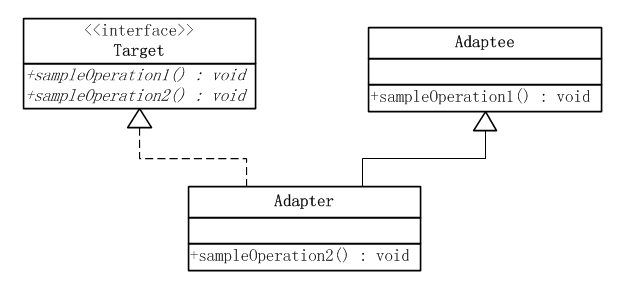一、适配器(Adapter)模式
是把一个类的接口变换成客户端所期待的另一种接口,从而使原本因接口不匹配而无法在一起工作的两个类能够在一起工作。
二、优点
- 更好的复用性
系统需要使用现有的类,而此类的接口不符合系统的需要。那么通过适配器模式就可以让这些功能得到更好的复用。
- 更好的扩展性
在实现适配器功能的时候,可以调用自己开发的功能,从而自然地扩展系统的功能。
三、缺点
过多的使用适配器,会让系统非常零乱,不易整体进行把握。比如,明明看到调用的是A接口,其实内部被适配成了B接口的实现,一个系统如果太多出现这种情况,无异于一场灾难。因此如果不是很有必要,可以不使用适配器,而是直接对系统进行重构。
四、用途
用电器做例子,笔记本电脑的插头一般都是三相的,即除了阳极、阴极外,还有一个地极。而有些地方的电源插座却只有两极,没有地极。电源插座与笔记本电脑的电源插头不匹配使得笔记本电脑无法使用。这时候一个三相到两相的转换器(适配器)就能解决此问题,而这正像是本模式所做的事情。
五、结构
适配器模式有类的适配器模式和对象的适配器模式两种不同的形式。
① 类适配器模式(类的适配器模式把适配的类的API转换成为目标类的API。)

在上图中可以看出,Adaptee类并没有sampleOperation2()方法,而客户端则期待这个方法。为使客户端能够使用Adaptee类,提供一个中间环节,即类Adapter,把Adaptee的API与Target类的API衔接起来。Adapter与Adaptee是继承关系,这决定了这个适配器模式是类的:
模式所涉及的角色有:
● 目标(Target)角色:这就是所期待得到的接口。注意:由于这里讨论的是类适配器模式,因此目标不可以是类。
● 源(Adapee)角色:现在需要适配的接口。
● 适配器(Adaper)角色:适配器类是本模式的核心。适配器把源接口转换成目标接口。显然,这一角色不可以是接口,而必须是具体类。
eg:
public interface Target {
/**
* 这是源类Adaptee也有的方法
*/
public void sampleOperation1();
/**
* 这是源类Adapteee没有的方法
*/
public void sampleOperation2();
}
上面给出的是目标角色的源代码,这个角色是以一个JAVA接口的形式实现的。可以看出,这个接口声明了两个方法:sampleOperation1()和sampleOperation2()。而源角色Adaptee是一个具体类,它有一个sampleOperation1()方法,但是没有sampleOperation2()方法。
public class Adaptee {
public void sampleOperation1(){}
}
适配器角色Adapter扩展了Adaptee,同时又实现了目标(Target)接口。由于Adaptee没有提供sampleOperation2()方法,而目标接口又要求这个方法,因此适配器角色Adapter实现了这个方法。
public class Adapter extends Adaptee implements Target {
/**
* 由于源类Adaptee没有方法sampleOperation2()
* 因此适配器补充上这个方法
*/
@Override
public void sampleOperation2() {
//写相关的代码
}
}
② 对象适配器模式
与类的适配器模式一样,对象的适配器模式把被适配的类的API转换成为目标类的API,与类的适配器模式不同的是,对象的适配器模式不是使用继承关系连接到Adaptee类,而是使用委派关系连接到Adaptee类。

从上图可以看出,Adaptee类并没有sampleOperation2()方法,而客户端则期待这个方法。为使客户端能够使用Adaptee类,需要提供一个包装(Wrapper)类Adapter。这个包装类包装了一个Adaptee的实例,从而此包装类能够把Adaptee的API与Target类的API衔接起来。Adapter与Adaptee是委派关系,这决定了适配器模式是对象的。
eg:
public interface Target {
/**
* 这是源类Adaptee也有的方法
*/
public void sampleOperation1();
/**
* 这是源类Adapteee没有的方法
*/
public void sampleOperation2();
}
public class Adaptee {
public void sampleOperation1(){}
}
public class Adapter {
private Adaptee adaptee;
public Adapter(Adaptee adaptee){
this.adaptee = adaptee;
}
/**
* 源类Adaptee有方法sampleOperation1
* 因此适配器类直接委派即可
*/
public void sampleOperation1(){
this.adaptee.sampleOperation1();
}
/**
* 源类Adaptee没有方法sampleOperation2
* 因此由适配器类需要补充此方法
*/
public void sampleOperation2(){
//写相关的代码
}
}
